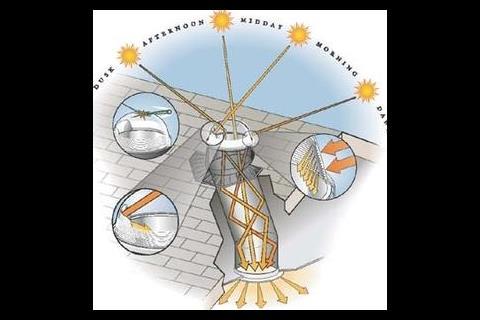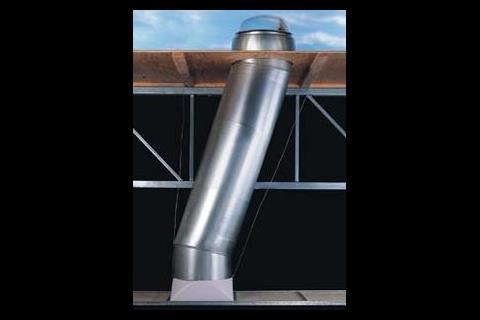This phenomenal growth rate is largely down to the fact that one of the biggest problems facing building designers and facilities managers is how to optimise the amount of natural light in buildings either by designing techniques in for new build or identifying innovative solutions to introduce daylight to existing buildings.
This requirement has been precipitated by a number of factors. An increasing trend towards open plan offices, with circulation spaces around the edges of buildings, means that workstations are often sited well away from windows so a means of illuminating the work environment has to be found.
Empirical evidence suggests that most people feel better about working in areas lit by natural light, but there is also a plethora of case study and research proof that there are tangible productivity, health, cost saving and environmental benefits from daylighting facilities.
In addition, there is increasing general interest and also various government initiatives that encourage both consumers and organisations in the public and private sectors to use energy more efficiently and consider whole life implications of building design. All of these have resulted in heightened awareness of and demand for the use of sustainable energy sources for the provision of light.
When are they used?
Tubular skylights provide a simple to install solution for providing daylight into a whole range of buildings from offices, retail outlets, factories and warehouses, schools, hospitals and libraries through to residential properties. They are cost-effective when compared with traditional roof-lights, require no structural changes to existing buildings and do not bring with them the disadvantages of heat transfer associated with large expanses of glass. In addition, they are more secure than windows or roof-lights, a major consideration especially in the public sector in, for example, schools and hospitals. Put very simply, a tubular skylight consists of a clear dome that is fitted to the roof to collect natural light. This light is then channelled down through super reflective tubing, through an emitter/diffuser to where it is needed in the room below. The various products available incorporate a selection of standard and optional features that aim to optimise the amount of daylight that is harvested and transmitted from roof to room, with differing levels of success. Typically these may include reflectors fitted inside the dome, a choice of shape in domes and styles of diffusers and an assortment of reflective materials inside the tubes.
The evidence
While choice is a good thing, until recently the wide variety of options could be confusing with most manufacturers making similar claims for their products with little scientific evidence either to prove or disprove them.
However, Dr David Carter, President of CIBSE's Society of Light and Lighting and a Reader in the School of Architecture and Building Engineering at The University of Liverpool, is investigating user perceptions of tubular skylight installations.
The fundamental question is whether daylight delivered into a room via a tube in a similar manner to a conventional luminaire is still perceived as daylight, and whether the generally assumed advantages of daylight are still felt when most of the familiar properties of daylight and in some cases reference to the outside world are missing. He carried out a series of surveys of clerical areas lit using tubular skylights. His initial conclusions showed that for the most part the skylights were recognised as daylight devices which enabled users to detect weather variation and time of day, and made a contribution to task illuminance with minimal glare. They were also regarded as being environmentally friendly and contributing to improvement of the interior and its occupants' workspaces.
More comprehensive results are available from a recently produced Building Research Establishment (BRE) test report entitled Measurements of the transmittance of light pipes (tubular skylights). Under overcast and simulated sunlit conditions the report reveals significant differences in transmittance efficiency between the three most frequently specified tubular skylights in the UK. This is the first independent assessment of the transmittance of tubular skylights conducted in the UK.
The test programme measured light transmittance of tubular skylights, each with 2·7 m tubes, from the three main players in the UK market. The tests were devised and managed by Dr Paul Littlefair, BRE's principal lighting consultant and Hilary Graves, BRE's senior lighting consultant, both of whom have a great deal of experience in examining lighting issues. They have also written a number of articles and books on a wide range of light-related topics including Paul Littlefair's Designing with innovative daylighting (BRE, Garston, 1996), which includes a chapter on tubular skylights.
The tubular skylights tested were measured both under overcast conditions and also under simulated sunlight at three different solar altitudes. Each was measured with the top dome and bottom emitter/diffuser in place.
The transmission factor T is defined as the light emitted from the tubular skylight system divided by the light entering it. The total light F emerging from the system in lumens is given by F=ETA where A is the aperture area and E is the illuminance at the top of the pipe.
Paul Littlefair explains: "The transmittance is a useful parameter because it allows the lighting designer to calculate how much light enters the indoor space under different daylighting conditions. It is also an objective way to compare the performance of different pipes."
The simulated sunlit conditions were produced using BRE's integrating box inside which a photocell was installed to collect and account for all of the light transmitted through the tubular skylights.
The box is usually used to measure the diffuse transmittance of rooflight glazing and had to be modified for testing the tubular skylights. Special aperture plates were constructed with a circular hole equal to the diameter of the tubes. The ratio of the illuminance in the box with the tube to that with the aperture plate then corresponds to the transmittance of the pipe system.
Typically, BRE undertakes testing under overcast sky conditions in its artificial sky facility. However, the tubes were too long for this to be possible so the tests were conducted under the real sky on an overcast day. During the measurement the sky was covered in cloud and the solar disk was invisible. The conclusion of the tests was that even though the mechanisms may look similar, there is a variance in performance.
Paul Littlefair comments: "The test results show that there is a significant difference in the amount of light transmitted through the various tubular skylights. Their design and the reflective material used has a major impact on their transmittance."
The future for tubular skylights
With the drive to greater energy efficiency increasing, methods of lighting which can reduce power use look set for a healthy future. The advantage of tubular skylights is also growing along with a body of evidence that suggests daylight is far healthier for occupants. With the introduction of product enhancements the use of tubular skylights looks set to continue to increase. Enhancements currently available include a combined daylight and ventilation system, although there is some debate as to whether this compromises the effectiveness of required airflow.
Also available are light dampening systems such as blinds and butterfly valves to control the amount of light entering rooms. And as architects increasingly look to maximise both usable workspace and access to daylight in offices without the heat transfer disadvantages of large expanses of glass, tubular skylights look set to play an increasingly important role in the workplaces and homes of the future.
Tubular skylights provide a way for those responsible for the design and/or management of buildings to introduce natural light where windows or roof-lights are either impractical or undesirable. The results of the BRE testing programme show that specifiers' choice of tubular skylights can significantly influence both the cost and the effectiveness of the system and that tube diameter is not necessarily the decisive factor.
Health and daylight
There are many research programmes and evidence from industry around the world which point to the important part daylight plays in health and productivity.Source
Building Sustainable Design
























No comments yet